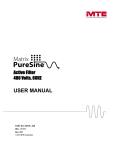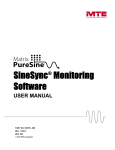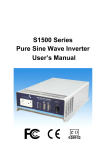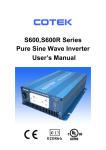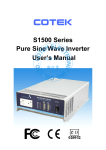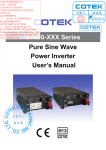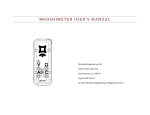Download PureSine 150/300 Pure Sine Wave Inverter User's Manual
Transcript
PureSine 150/300 Pure Sine Wave Inverter User’s Manual 1. Important Safety Instructions WARNING! Before you install and use your Inverter, please read and follow these safety instructions. 1-1. General Safety Precautions 1-1-1. Do not expose the Inverter to rain, snow, spray, bilge or dust. To reduce risk of hazard, do not obstruct the ventilation openings. Do not install the Inverter in a zero-clearance compartment as overheating may result. 1-1-2. To avoid the risk of fire and electric shock ensure all wiring and and cables are in good electrical conditions and of sufficient size. Do not operate the Inverter with damaged or substandard wiring. 1-1-3. The PS-150/300 contains components which can produce arcs or sparks. To prevent fire or explosion, do not install or use in compartments containing batteries, flammable materials or in locations that require ignition protected equipment. This includes any space containing gasoline-powered machinery, fuel tanks, joints, fittings, or other connections or components of any fuel system. 1-2. Precautions When Working with Batteries 1-2-1. If battery acid contacts skin or clothing, wash immediately with soap and water. If acid enters eyes, immediately flood eyes with running cold water for at least 20 minutes and get immediate medical attention. 1-2-2. Never smoke or allow a spark or flame in the vicinity of the battery or engine. 1-2-3. Do not drop any metal tools or equipment on the battery. Doing so may result in sparking or the short circuit of the battery or possible explosion. 1-2-4. Remove personal metal items such as rings, bracelets, necklaces, and watches when working with a lead-acid battery. A lead-acid battery can produces a short-circuit current high enough to weld a ring or the like to metal, causing severe burns. 2.Features 2-1. Electrical Performance Model No. Specification Item S150 - XXX 112 124 S300 - XXX 212 224 112 124 212 Continuous Output Power 150W 300W Surge Rating 300W 500W 224 Input voltage 12V 24V 12V 24V 12V 24V 12V 24V Input Voltage Range 10.5 – 15.0 21.0 – 30.0 10.5 – 15.0 21.0 – 30.0 10.5 – 15.0 21.0 – 30.0 10.5 – 15.0 21.0 – 30.0 Output Voltage 110 VAC ±5% 230 VAC ±5% Frequency 50 / 60Hz 110 V VAC ±5% 230 VAC ±5% ± 0.05% Efficiency (Peak Load) 91% 92% 90% 93% 92% 93% 91% 94% Efficiency (Max. / Avg.) 86% 87% 85% 88% 87% 88% 86% 89% Efficiency (Full Load) 72% 79% 72% 80% 72% 78% 72% 80% No Load Current Draw 0.18A 0.15A 0.22A 0.16A 0.26A 0.23A 0.23A 0.15A Output Waveform Pure Sine Wave ( THD < 4% ) Power Factor Allowed cosθ-90° ~ cosθ+90° Protection Overload, Short Circuit, Reverse Polarity (Fuse), Over / Under Input Voltage, Over Temperature. Remote Control Yes, On/Off controlled by external switch Safety* UL458 EMC** FCC Class B EN60950 EN50081-1 1992 EN50082-1 1992 EN55022B 1994 EN61000-4-2 1995 EN61000-4-3 1996 ENV50204 1995 Operating Temperature 0* – 40* C Storage Temperature -30* to 70* C Fan Cooling Thermostatically controlled Dimensions (L x W x H) Weight 200 x 132 x 72 mm 237 x 155 x 72 mm 7.87 x 5.20 x 2.83 inch 9.33 x 6.10 x 2.83 inch 2.7 Kgs. / 5.4 Lbs. 3.5 Kgs. / 7.7 Lbs. *110V mode design meets UL 458 & FCC Class B. **230V model design meets CE & “e “ Mark. (Currently, all applied projects are pending) 2-2. Mechanical Drawing (PS-150) Sinergex 2-3. Mechanical Drawing (PS-300) Sinergex 3. Introduction The Sinergex PureSine series are of the most, reliable, and high performing true sine wave inverters available. The PureSine inverters can be used in wide range of applications including portable office equipment, home entertainment products, computers and most AC powered products within each models size capabilities. To ensure maximum performance from your Sinergex PureSine inverter it must be installed and used correctly Please carefully read and follow the instructions in this manual before installation and operation of your inverter. 3-1. Front Panel Operations 3-1-1. ON / OFF/ REMOTE switch Leave the Power ON / OFF / REMOTE switch in the OFF position during installation. 3-1-2 LED display indicates Power Status LED Conditions Solid Green Blinked Red fast Blinked Red slowly Blinked Red intermittently Solid Red Status AC Power OK OVP UVP OTP OLP 3-1-3. Remote Port: Placing 0.75mm2 and Screw type wiring connecting the remote Port and remote panel. 3-2. Rear Panel Operations 3-2-1. Ventilation window: Do not obstruct. Allow at least 3 inches of clearance for airflow. 3-2-2. Input terminals: Connect 12V / 24V batteries or other 12V / 24V power sources. Red is positive, Black is negative. Reverse polarity connection will blow internal fuse and may damage inverter permanently and void warranty. 3-2-3. Using # 8 AWG wire connects Chassis ground and Vehicle Chassis. 4 WARNING! Do not connect the 12V model to a 24V battery; the unit will be destroyed immediately. Operation of the inverter without a proper ground connection may result an electrical safety hazard. Damage caused by reversed polarity is not covered by warranty. Make sure the power switch is in the OFF position before connecting to the battery. 3-3. AC Safety Grounding: During the AC wiring installation, AC input and output ground wires are connected to the inverter. The AC input ground wire must connect to the incoming ground of your AC utility source. The AC output ground wire should go to the grounding point for your loads ( for example, a distribution panel ground bus ). 3-3-1. Neutral Grounding (GFCI’S): 110V models: The neutral conductor of the AC output circuit of the Inverter is automatically connected to the safety ground during inverter operation. This conforms to National Electrical Code requirements that separately derived AC sources (such as inverter and generators) have their neutral conductors tied to ground in the same way that the neutral conductor from the utility is tied to ground at the AC breaker panel. For models configured with a transfer relay, while AC utility power is presenting and the inverter is in bypass mode, this connection (neutral of the Inverter’s AC output to input safety ground) is not present so that the utility neutral is only connected to ground at your breaker panel, as required. Sinergex has tested the following GFCI – protected 20A receptacles and found that they functioned properly when connected to the output of the Inverter WARNING! Never connect the inverter’s output to the AC distribution grid, such as your household AC wall outlet. Doing so will damage the Inverter and void warranty. 3-4. Installation Before connecting your applications to the inverter, always check the power draw of your appliances. The inverter will supply a greater surge power for a short time to start electrical equipment such as electric motors, pumps etc., that require more power while starting up. When all the above requirements are satisfied and all connections are made, it’s the time to turn on your inverter by pushing the power switch to the ‘ I ’ position. The sine wave output AC voltage gently rises from AC outlet. When the inverter is not supplying power to an application for a prolonged period of time, it’s recommended to turn off the inverter to save your batteries, since the inverter still draws a very small amount of current when there is no load connected. DC input voltage status as follows: DC Input over Voltage Model DC Input under Voltage Shut-down Restart Shut-down Restart 12V models 15.3 14.8 10.5 12.5 24V models 30.6 29.6 21.0 25.0 4. Troubleshooting guide: WARNING! Do not open or disassemble the inverter. Attempting to service the unit yourself may result in a risk of electrical shock or fire and void warranty. Problems and Symptoms Possible Cause No output voltage, the LED glows RED light. Solutions a. Power status light blinks RED fast. b. Power status light blinks RED slowly. Over input voltage. Check input voltage. Reduce input voltage. Recharge battery. Check connections and cable. c. Power status light is blinks RED intermittently. Thermal shutdown Improve ventilation. Make sure inverter’s vents are not obstructed. Reduce ambient temperature. d. Power status light glow steady RED. Short circuit, Wiring error. Over Load Check AC wiring for short circuit. Remove load. Low input voltage.











